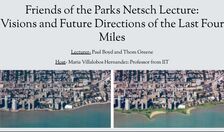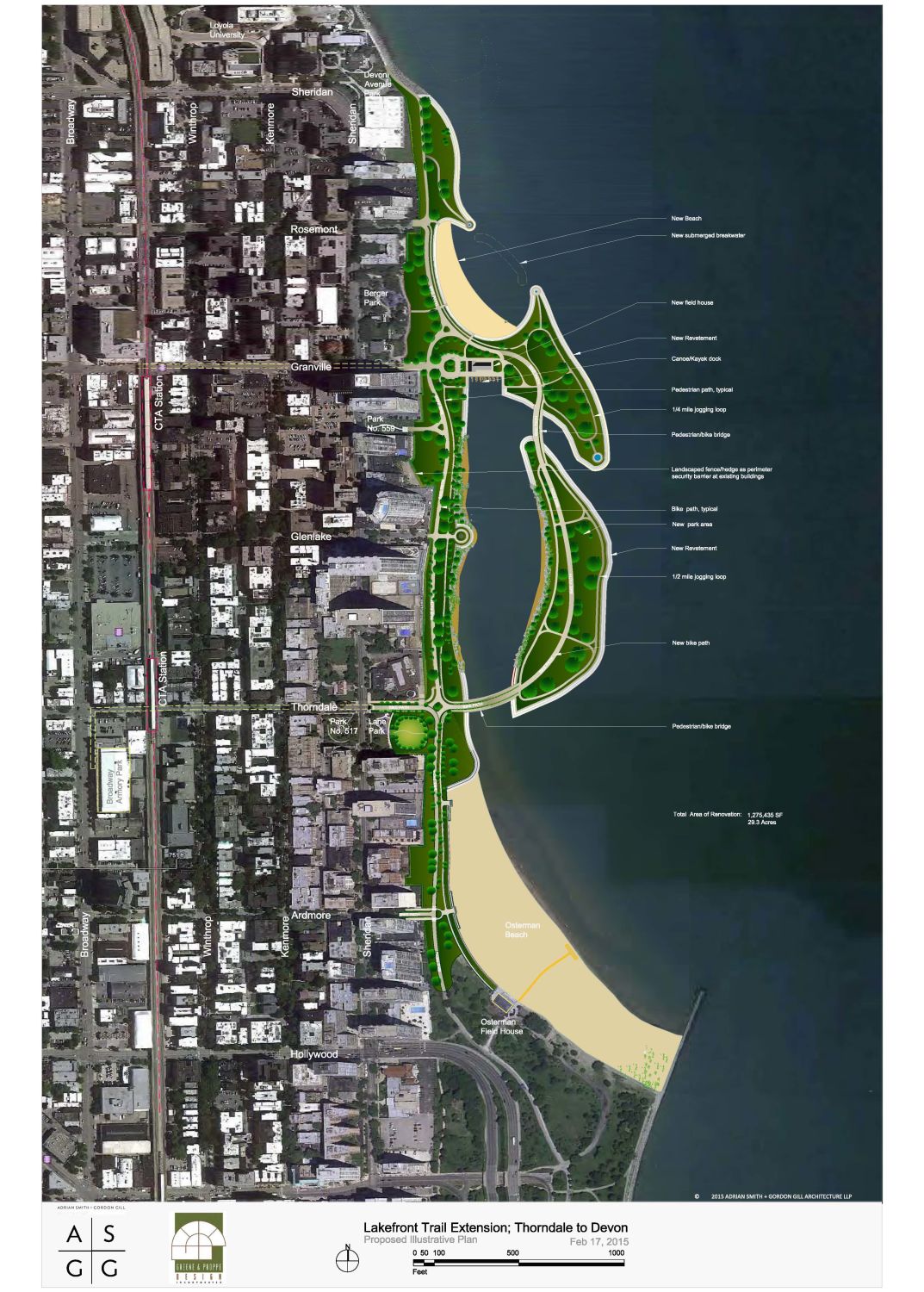Last Four Miles
|
The Last Four Miles Plan would add almost 500 acres of new parks and beaches, which provide recreational and health benefits for urban dwellers. The plan would complete a single lakefront-long park to knit the city together and extend the lakefront trail for walkers, runners, and cyclists—to Evanston on the north and to the Indiana border on the south.
Chicago is one of the world’s most beautiful cities, unequaled among large industrial cities, due to the vision of our founding citizens and park advocates. Credit for preserving our lakefront heritage first belongs to the trustees of the Illinois and Michigan Canal who, when selling city lots in 1836, crafted a caveat that protected a portion of Chicago’s lakefront to be “forever…open, clear and free.” Preservationists and environmental champions such as Fredrick Law Olmsted and A. Montgomery Ward followed, establishing and preserving important natural and man-made lakefront parcels that eventually became Jackson Park and Grant Park. The culmination of this preservationist tradition was crafted by Daniel J. Burnham and Edward Bennett in their classic Plan of Chicago, 1909. The Chicago Plan established a unique vision for the city that sets us apart from most cities in this country, and indeed, all across the globe. Our 26 miles of public lakeshore park system creates a beautiful park expanse that is unrivaled around the world for its beauty and public accessibility. In the years that followed 1909, several city administrations and generations of citizens took up Burnham’s bold plan. Taxpayers approved referendum after referendum to pay the costs of creating the landfill for parks stretching north to Hollywood and south to 71st Street. Through the 1950’s the City implemented much of the lakefront plan, to the point where today, 26 of Chicago’s 30 miles of lakeshore boast public parks and amenities for the recreational enjoyment of all. Yet for the last nearly sixty years, there has been a conspicuous absence of definitive action to complete Burnham’s lakefront plan. While nearly everyone agrees that Burnham’s open shoreline project has helped to make Chicago one of the world’s great cities, and most concur that the great plan should be completed, no concrete steps have been taken by the City in over 50 years to complete the system and achieve the 30 mile goal. In addition, the first policy of the Lake Michigan and Chicago Lakefront Protection Ordinance specifically calls for the City of Chicago to “Complete the publicly owned and locally controlled park system along the entire Chicago Lakefront…” (Adopted December, 1973) |
LEARN MORE ABOUT THE VISION
|
Partnerships
When Friends of the Parks held a charrette in preparation for making the Last Four Miles Plan (2006) we engaged many groups, councils, and individuals. This is a partial list of the people who contributed to our efforts:
When Friends of the Parks held a charrette in preparation for making the Last Four Miles Plan (2006) we engaged many groups, councils, and individuals. This is a partial list of the people who contributed to our efforts:
- Friends of the New Lakefront
- The South Shore Cultural Center Advisory Council
- Edgewater Community Council
- Edgewater Chamber of Commerce
- Bush Neighbors Association
- Alliance for the Great Lakes
- Loyola Park Advisory Council
- Berger Park Advisory Council
- Rainbow Beach Advisory Council
- Lincoln Park Advisory Council
- Sierra Club
- Chicagoland Bike Federation
- Burnham Park Advisory Council
- Bird Conservation Network
- Southeast Environmental Task Force
- Edgewater Historical Society
- Harbor Advisory councils
- Howard Area Community Council
- Devcorp North
- Rogers Park Community Council
- Centro Romero
LEARN MORE FROM RESEARCH STUDIES:
- Trust for Public Land, Health Benefits of Parks: How Parks Help Keep Americans and Their Communities Fit and Healthy, 2007
- Increasing Physical Activity. A Report on Recommendations of the Task Force on Community Preventive Services, Centers for Disease Control & Prevention, October 1, 2001.
- “Illinois adults getting fatter; State ranks 26th in U.S. for obesity,” Chicago Tribune, June 29, 2010
Economic benefits
Completing the Last Four Miles would increase property values adjacent to the new parkland and beach areas, as well as promote economic revitalization with new small businesses in the vicinity of the new lakefront parks. New construction jobs would be generated.
Completing the Last Four Miles would increase property values adjacent to the new parkland and beach areas, as well as promote economic revitalization with new small businesses in the vicinity of the new lakefront parks. New construction jobs would be generated.
- Gies, Erica. The Economic Benefits of Parks and Open Space. (PDF) Trust for Public Land, 2009
- Harnik, Peter and Ben Welle. Measuring the Economic Value of a City Park System (PDF)Trust for Public Land, 2009
- How Smart Parks Investment Pays its Way: Analysis of Secondary Economic Impacts of Park Expenditures on New York City Parks. A joint study by New Yorkers 4 Parks and Ernst & Young, 2002.
- Lutzenheiser, M. and N. Noelwahr, 2001. “The Effect of Open Spaces on a Home’s Sale Price.” Contemporary Economic Policy 19 3): 291-298
- The Impact of Hudson River Park on Property Values Study. Commissioned by Friends of Hudson River Park, researched by the Regional Plan Association with support from the Real Estate Board of New York, October 2008.
- Miller, A.R. Valuing Open Space: Land Economics and Neighborhood Parks. MIT Center for Real Estate, 2001
Edwards, Karin Marie. Do Parks Make Cents? An Analysis of the Economic Value of Parks in San Francisco (PDF) Prepared for the San Francisco Neighborhood Parks Council, May 2007 - Uhlir, Ed. “The Millennium Park Effect: Creating a Cultural Venue with an Economic Impact,” (PDF) Economic Development Journal, Spring 2005
- Schwartz, Anne. “Good Parks are Good for the Economy,” Gotham Gazette, July 2009
- Shaikh, S. L. “Uncovering Economic Values for Beach Use,” Presentation for the NOAA Center of Excellence for Great Lakes and Human Health, University of Michigan, Ann Arbor, February 2006.
- The Economic Benefits of Open Space, Recreation Facilities and Walkable Community Design Active Living Research Synthesis, May 2010
- The Impact of Hudson River Park on Property Values Study A study commissioned by Friends of Hudson River Park, researched by the Regional Plan Association with support from the Real Estate Board of New York, October 2008.
- Carleyolsen, Sanya, Tanya Meyer, Joseph Rude, and Ian Scott. Measuring the Economic Impact and Value of Parks, Trails and Open Space in Jefferson County (PDF) Prepared for Jefferson County Parks Department and Wisconsin Department of Natural Resources, Dec. 2005
Ecological benefits
Besides providing additional recreational amenities, the Last Four Miles of new parks and beaches also contribute to Chicago’s long term environmental sustainability. The new parks and beaches would provide shoreline protection from storms and erosion. The new parkland would create aquatic and wildlife habitat and support birds on the migratory bird flyway. Five hundred acres of new ecologically sustainable parks and beaches would improve the air and water quality of Chicago and benefit Lake Michigan’s ecosystem.
Besides providing additional recreational amenities, the Last Four Miles of new parks and beaches also contribute to Chicago’s long term environmental sustainability. The new parks and beaches would provide shoreline protection from storms and erosion. The new parkland would create aquatic and wildlife habitat and support birds on the migratory bird flyway. Five hundred acres of new ecologically sustainable parks and beaches would improve the air and water quality of Chicago and benefit Lake Michigan’s ecosystem.
- Austin, John C., Soren Anderson, Paul N. Courant, Robert E. Litan, Healthy Waters, Strong Economy: The Benefits of Restoring the Great Lakes Ecosystem, (PDF) The Brookings Institution, September 2007
- Chicago Shoreline Protection Commission, Recommendations for Shoreline Protection and Recreational Enhancement, 1988.
- “Safeguarding the Environment,” from The Economic Benefits of Open Space, The Trust for Public Land, 1999
- Chrzastowski, Michael. “Planning for the Future of Chicago’s Lakefront,” Shore & Beach,Vol. 59, pp. 2-10, April 1991.









